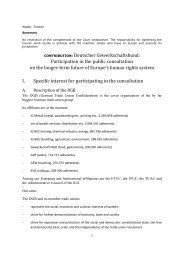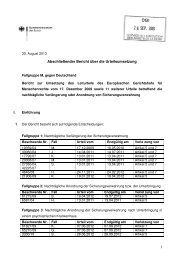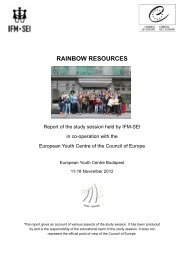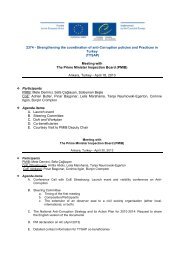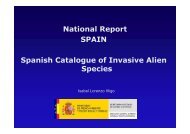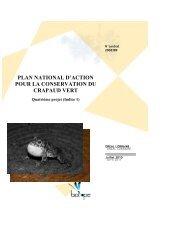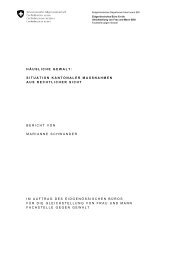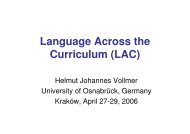Money laundering through money remittance ... - Council of Europe
Money laundering through money remittance ... - Council of Europe
Money laundering through money remittance ... - Council of Europe
You also want an ePaper? Increase the reach of your titles
YUMPU automatically turns print PDFs into web optimized ePapers that Google loves.
<strong>Money</strong> Laundering <strong>through</strong> <strong>Money</strong> Remittance and Currency Exchange Providers - 2010 <br />
65. In countries where there are many MR/CE service providers, it is difficult to cross-match<br />
data, and the risk <strong>of</strong> being involved in “smurfing” schemes is therefore typically higher than in<br />
countries where there are few service providers. The abundance <strong>of</strong> MR/CE service providers makes<br />
structuring a relatively “safe” choice for the criminals in most countries and minimises the possibility<br />
that law enforcement agencies might detect such activity unless there is well-functioning co-operation<br />
at the national level that then helps to identify smurfing schemes that may be using multiple service<br />
providers.<br />
66. It is <strong>of</strong>ten very difficult to find a link between persons using <strong>money</strong> <strong>remittance</strong> services for<br />
the transfer <strong>of</strong> funds because the transaction paper trail is <strong>of</strong>ten lacking. The nature <strong>of</strong> MR/CE<br />
business is that service providers <strong>of</strong>ten carry out one-<strong>of</strong>f transactions with occasional customers, and<br />
many <strong>of</strong> the customer relationships that do exist are not <strong>of</strong> a durable nature. In the case <strong>of</strong> one-<strong>of</strong>f<br />
transactions, some MR/CE service providers are not able to monitor the financial behaviour <strong>of</strong> their<br />
customers in the same way as a traditional bank is able to do with its customers.<br />
67. As a consequence, due diligence measures applied by some MR/CE service providers in less<br />
developed markets are usually at most confined to identification and verification <strong>of</strong> the identity <strong>of</strong> the<br />
person, without the possibility <strong>of</strong> ongoing monitoring <strong>of</strong> the customer‟s activities. In addition to the<br />
name <strong>of</strong> the customer, the indication <strong>of</strong> the beneficiary (sender or receiver), the destination or origin <strong>of</strong><br />
the funds, limited additional information is typically available for MR/CE providers.<br />
68. Another method commonly identified in <strong>money</strong> <strong>laundering</strong> schemes is the use <strong>of</strong> straw men<br />
(so-called „<strong>money</strong> mules‟). A <strong>money</strong> mule is a natural person who makes his (bank) account available<br />
to a criminal or criminal organisation receiving some form <strong>of</strong> remuneration in return. A <strong>money</strong> mule is<br />
<strong>of</strong>ten solicited via a spam e-mail to accept a transfer <strong>of</strong> <strong>money</strong> –received from the victim(s) <strong>of</strong> a<br />
criminal or <strong>of</strong> a criminal organisation – which he/she then is instructed to transfer to the account <strong>of</strong><br />
another person, whose personal details the <strong>money</strong> mule also receives via e-mail. The <strong>money</strong> mule is<br />
allowed to retain a part <strong>of</strong> the <strong>money</strong> for the services rendered to the criminal or criminal organisation.<br />
Customer: individual<br />
Mechanism: <strong>money</strong> <strong>remittance</strong><br />
Box 2. Use <strong>of</strong> „<strong>money</strong> mules‟<br />
Red-flag indicators: use <strong>of</strong> straw men, organised criminals involved<br />
Case description: An FIU from country A received a request for information from country B that<br />
involved among others company X, known to be alleged to have laundered funds by making multiple<br />
wire transfers to launder fraudulent card billing proceeds. According to this request a criminal network<br />
involved in credit card fraud schemes was using mules to transfer the pr<strong>of</strong>its <strong>of</strong> the illegal business to<br />
different parts <strong>of</strong> the world. The mules were instructed to send <strong>money</strong> only via <strong>money</strong> <strong>remittance</strong><br />
services to hide the origin <strong>of</strong> the pr<strong>of</strong>its.<br />
The undercover agent <strong>of</strong> country A succeeded to come in contact with one <strong>of</strong> the leading persons <strong>of</strong><br />
this network (person C). The undercover agent convinced person C that it is better to use wire<br />
transfers <strong>through</strong> banking institutions instead <strong>of</strong> <strong>money</strong> <strong>remittance</strong> <strong>of</strong>fices. This was done because the<br />
authorities <strong>of</strong> country A were trying to identify persons behind bank accounts instead <strong>of</strong> mules sending<br />
<strong>money</strong> via <strong>money</strong> <strong>remittance</strong> services.<br />
Person C instructed the undercover agent to send <strong>money</strong> to company‟s X account in country A. From<br />
analysis carried out, it appeared that the <strong>money</strong> was transferred from country A to country B and most<br />
probably to accounts owned by the leaders <strong>of</strong> organised crime in that country.<br />
Source: Cyprus.<br />
69. The ultimate purpose for structuring transactions is to conceal the true beneficiary <strong>of</strong> the<br />
transaction and the origin <strong>of</strong> the <strong>money</strong>. Therefore, another potential risk for the MR/CE provider<br />
© 2011 MONEYVAL and FATF/OECD - 23



